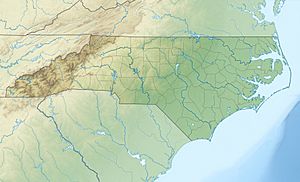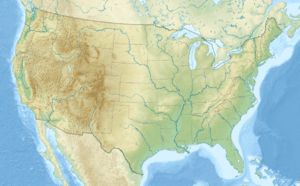Long Branch (Trent River tributary) facts for kids
Quick facts for kids Long Branch |
|
|---|---|
|
Location of Long Branch mouth
|
|
| Other name(s) | Tributary to Trent River |
| Country | United States |
| State | North Carolina |
| County | Jones |
| Physical characteristics | |
| Main source | Bachelor Creek divide about 5 miles northwest of Jones Corner, North Carolina 38 ft (12 m) 35°04′39″N 077°16′08″W / 35.07750°N 77.26889°W |
| River mouth | Trent River about 1.5 miles northwest of Oak Grove, North Carolina 3 ft (0.91 m) 35°04′39″N 077°15′25″W / 35.07750°N 77.25694°W |
| Length | 2.83 mi (4.55 km) |
| Basin features | |
| Progression | generally southwest |
| River system | Neuse River |
| Basin size | 2.92 square miles (7.6 km2) |
| Tributaries |
|
| Bridges | Ben Banks Road, Ten Mile Fork Road |
Long Branch is a small stream in Jones County, North Carolina, United States. It flows for about 2.83 mi (4.55 km), which is a little less than 3 miles. This stream is a "tributary" to the Trent River. A tributary is a smaller stream or river that flows into a larger one.
Contents
The Journey of Long Branch
Long Branch begins its journey about 5 miles northwest of a place called Jones Corner, North Carolina. This is where the stream starts to form.
Flowing Southwest
From its starting point, Long Branch flows generally towards the southwest. It winds its way through the land, collecting water as it goes.
Joining the Trent River
After flowing for nearly 3 miles, Long Branch reaches its end. It flows into the Trent River. This meeting point is about 1.5 miles northwest of Oak Grove, North Carolina.
Understanding the Watershed
Every river and stream has a "watershed." A watershed is like a big bowl or area of land where all the rain and snowmelt drain into a specific river or stream.
Long Branch's Drainage Area
The watershed for Long Branch covers an area of about 2.92 square miles (7.6 km2). This means all the water that falls on this area will eventually flow into Long Branch.
Rainfall and Forests
This area receives a good amount of rain, about 53.8 inches each year. A large part of the Long Branch watershed, about 21%, is covered by forests. These forests are important because they help keep the water clean and provide homes for wildlife.
Why Small Streams Matter
Even small streams like Long Branch are very important parts of our environment. They play a big role in the health of larger rivers and the surrounding land.
Supporting Ecosystems
Small streams provide habitats for many plants and animals. Fish, insects, and other creatures live in and around these waters. The trees and plants along the banks help keep the water cool and clean.
Connecting Water Systems
Long Branch is part of a larger system. It flows into the Trent River, which then flows into the Neuse River. This shows how all waterways are connected, from the smallest stream to the largest river. Protecting small streams helps protect the entire river system.



